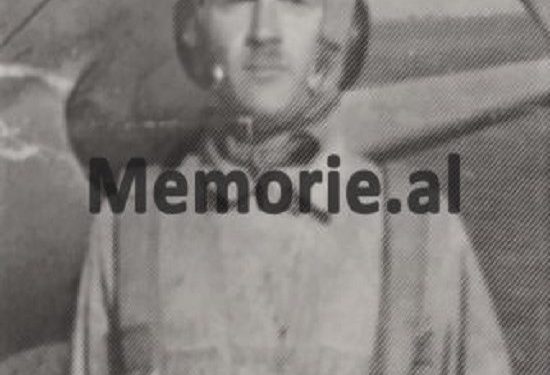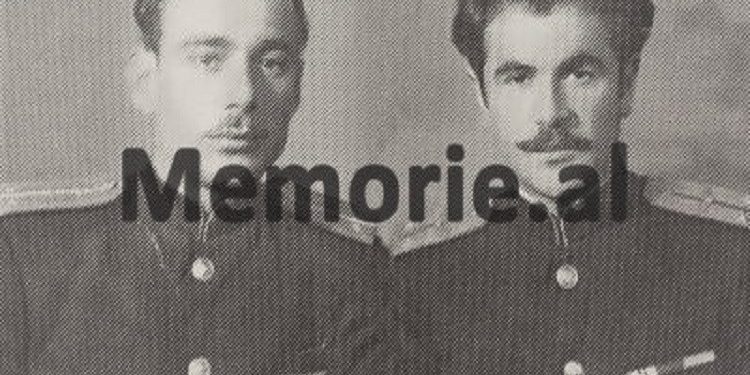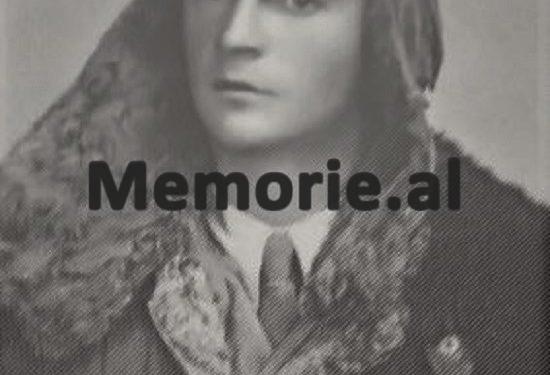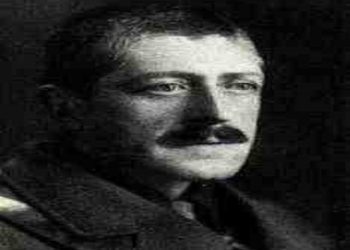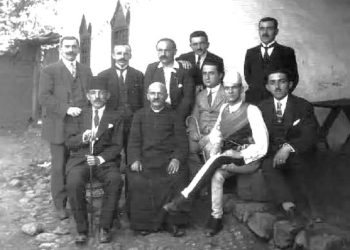Dashnor Kaloçi
Memorie.al publishes the unknown story of pilot Hasan Mete Shyti, who after graduating from Pancevo, Yugoslavia and the Aviation Academy of the Soviet Union, served for more than 30 years as a military man with the rank of major in senior positions, as chief Headquarters of the Aviation Regiment and Air Detection in the State Air Defense, and lecturer at the Military Academy “Mehmet Shehu” in Tirana. His testimony about the rare event that took place in the distant May of 1948, when he was studying at the Military Aviation Academy in the neighboring country, where during a training with his plane he crashed in the hills on the outskirts of the city of Skopje and the Commander of To the 113th Air Regiment of the Yugoslav Army, Lazaravski said: “I took part in World War II and saw planes crash, but I would never believe to see the pilot get up…” ?!
Aircraft technician Socrates, who was my friend, tied me so tightly in the pilot seat that I remembered that I could no longer move to perform the proper maneuvers in the cockpit. Meanwhile, on the radio squad commander, Stanisavlevic, a Serbian protester, called me to go to the start. After I made three dives, suddenly in the fourth drip, the aircraft engine stopped and the propellers stopped spinning. I thought it was a defect and according to the instruction I had to find a paved place outside the airport to sit on. Jumping with a parachute was impossible, because I did not have the right height. Approaching the ground, I pulled the steering wheel firmly away from myself and the plane crashed into a hill. “My eyes darkened and I closed them instinctively.” This is how Hasan Mete Shyti, one of the pioneers of the Albanian Military Aviation, remembered that distant event where his life was in the “thread of a feather” and none of his colleagues who rushed to help him, would believe them. eyes when they saw that he had escaped alive?! A graduate of the Air Force academies of Yugoslavia and the Soviet Union, after spending over 30 years of his life as a soldier of this weapon, with high duties as Chief of Staff of the Aviation Regiment and Air Detection in the State Air Defense, e lecturer at the Military Academy “Mehmet Shehu”, Hasan Mete Shyti could not easily forget that tragic event when on May 19, 1947 while conducting a combat shooting with a plane, he crashed in the hills of Skopje. But who is Hasan Shyti, what is his past and how did the event happen that almost turned into a serious tragedy that would have cost him his life and how could he come out alive from the wreckage of the plane? Regarding this and other events from his life, Memorie.al brings them in this article according to his testimonies and memories that he gave us years ago.
Student in Korça and partisan
Hasan Shyti was born on February 14, 1925 in the village of Tragjas in Vlora, where his family is from, very well known in that area. After finishing primary school in his village of Tragjas in 1933-’38, Hasani won a competition to attend classes at the Korca State High School. In that Lyceum, Hasani together with his friends: Dalan Shapllo, Esat Golemi, Foto Çami, Hysen Baboçi etc., attended classes for two years and in 1940, he was transferred to the Lyceum of the city of Gjirokastra, until he finished it in 1943. After graduating Hasani returned to his village, where the Shyti family, like many other well-known families of that province, was closely associated with the Anti-Fascist Movement. Hasani together with his fellow villager and his close friend, Niko Hoxha (years later one of the best aviators in Albania), became a partisan in the gang of “Youth of Vlora”, commanded by Mehmet Jaho, otherwise known as nicknamed “Luftar Bolena” and together with Niko on August 8, 1943, were accepted into the ranks of the Albanian Communist Party in the Vlora district. During the war years, Hasani maintained constant contacts and cooperated closely with the main leaders of the Anti-Fascist Movement of Vlora district, such as Kastriot Muço, (People’s Hero) Shyqëri Alimerko (People’s Hero) Bejto Isufi, Arif Hasko, Reiz Malile etc., taking part in all the fighting that their squad conducted in the province of Vlora.
In Pancevo, Yugoslavia
After the end of the war, in October 1945, Hasan, together with a group of former partisans, were sent to study at the Air Force School in Pancevo, Yugoslavia. In this school together with Hasan, were as students and Babaçe Faiku (later the first pilot of Enver Hoxha) Sazan Xhelo, Vasil Trasha, Peço Polena, Irakli Grazhdani, Mili Gribizi etc. After graduating from the school where Hasan Shyti graduated with honors, in November 1947, as the Air Force had not yet been established in Albania, he was appointed as a pilot in the 113th Yugoslav Air Regiment, which was installed near Skopje, as part of the Federation of Yugoslavia. In this regiment, a very tragic event would happen to Hasan, which almost cost him his life and came after a flight with a “Jak-9M” fighter plane, during a training with combat ammunition at a nearby firing range the city of Kumanovo. But how did that event happen and how could the pilot Hasan Shyti escape alive, after his plane from a height of 1000 m, crashed on the hills of the city of Skopje?
Defect in flight
That distant story that although there were no casualties, is one of the first disasters of Albanian aviators, which would continue until the early 90s with nearly 32 pilots who lost their lives due to air tragedies with their planes. Hasan Shyti, the first Albanian pilot who had the misfortune to crash with his plane, recalled that event: “It was May 19, 1948. The day was warm and sunny and the airport was covered with spring greenery. We Albanian pilots who were in that foreign country were told: ‘Let’s protect Albania from here’. That day we had an air strike with ammunition against ground objects that were in a range which was located along the railway road, the horn of the hills of Kumanovo. After boarding the plane, Socrates, my fellow Albanian technician, came to me to help me get off the flight. He sang a love song in Serbian, tied me so tightly in the cockpit that I could not move and at one point I thought it would prevent me from making the right moves in the cockpit, such as opening and closing the wheels and pilot command. Meanwhile, the squadron commander, a very arrogant Serbian captain named Stanisavlevic, was calling me on the radio. So, embarrassed by the connection that Socrates had made to me, I went to the start and gave gas to the plane and after 30 km. flight, I was on the firing range which was located by the road leading to Kumanovo, in a hilly terrain. Once I was at an altitude of 1000 m. I got in touch with the shooting chief who was also the leader of the firing range, Serbian Captain Sekulic, and I immediately started firing. Passing the plane at the dive, I noticed that my eyes corresponded in a straight line with the target and the target. The “Jak-9M” aircraft I was flying was of the firing type and had a 20 mm cannon as its weapon. two 12.7 machine guns and two 100 kg bombs. After making three dives, I suddenly noticed that in the fourth drip, the engine stopped and the propellers stopped spinning. During the shooting I had consumed all 20 cannonballs and this gave me the opportunity to try to land the plane in a paved place outside the aerodrome, as was the instruction. Meanwhile many quick thoughts came to my head: To sit down or parachute? To jump with a parachute, I had to have the right height, which I lacked and the only way was to try to land with the plane “, recalled the first moments of the accident, retired major, Hasan Shyti.
How did he escape death?!
What happened next to the pilot Hasan Shyti, how he maneuvered with his fighter plane and how he managed to get out alive from the wreckage of the plane that fell from a height of 1000 m. on the hills of the city of Skopje?! In this regard, Hasan Shyti recalled: “As the plane was speeding towards the ground, I tried to make a 360-degree rotation, which I could not achieve. I could barely turn 90 degrees by bringing the plane to the transverse position with the firing range. Meanwhile the range boss was talking to me but I did not understand well. Losing the heights, I tried to start the engine again, which was quite impossible. I removed the radio cable from the socket and opened the cab. Approaching the ground, I pulled the steering wheel away from myself to sit down. I dropped the shots and the plane crashed hard on the hill. My eyes darkened and I closed them instinctively. It seemed to me that I was losing it. In those moments I felt myself thrown out of the plane, like an ordinary piece rolled along with the cockpit. I lost my senses. I do not remember when I was mentioned. I did not remember what had happened and where I was. Around me lay the pieces of the wrecked plane. Was I alive?! I was immediately sorted out quickly and started touching my limbs and body with my hand. I did not feel any pain. An elderly man with his son appeared next to me. He was a Kosovar shepherd and he spoke to me in Serbian, after he thought of me as such: What did you do like that, boy?! At first, I did not feel it, but when he asked me where I was from, I told him that I was Albanian. He addressed me again saying: Why did you come here, boy, to leave the bones to go? I was so haunted and answered you: Unity-brotherhood, uncle, we are defending Albania with planes. Meanwhile, the leader of the range, Sekulic, arrived and the Kosovar and his son left. As I was getting up to report to him, he could not believe his eyes when he saw me standing and did not know what to say. After a while he said: Thank you boy that you saved that we will make the plane again. “These warm words spoken from the heart at that moment, were an encouragement to me in those moments”, recalled Hasan Syti, one of the first Albanian pilots to see death with his own eyes.
Yugoslavs: How did the pilot get up?
After the plane crash, the Yugoslav pilot Shyti, who miraculously escaped death, was shown special care by the Yugoslavs. Regarding this, he recalled: “Looking at me from head to toe, Sekulic was amazed at my good condition. As I later learned, he had announced at the aerodrome that a serious incident had taken place in test site No. 52. I do not know how much time had passed when two PO-2 planes landed at the range. Six people came with them, members of the extraordinary event verification commission. After being asked about the accident and my health condition, they told me to go and calm down. Then the Serbian captain, Sekulic, picked me up on his PO-2 and sent me to the airport. When my friends saw me at the door of the plane, I could not describe their surprise and shouts of joy. All my Albanian and Yugoslav comrades were gathered there, very sad about what had happened, and they heard in amazement about the event that was the first of its kind since the creation of the 113th Air Regiment. Vasil Trasha, my friend (who later died at a very young age, in a plane crash in Kuçova) accompanied me to the hospital together with Sekulic. The doctor as soon as he started visiting me told me that I had suffered a breakdown. Black marks of demolition were visible on the body at all cab connection points and at the joints. At that time, we Albanian pilots lived in a private house in Skopje. That night when I slept I dreamed, as if I were diving into the mountain and waking up terrified. After three days I went back to the aerodrome and saw that the pieces of the plane had been collected by Muharrem Spaho with the others, which they had taken there as trophies. I did not see Socrates anywhere, although his strong bond had saved my life. I noticed that the squadron commander, Stanistavlevic, had not scheduled me for the flight. He told me that my problem would be looked at once again, but I insisted and protested saying I should continue piloting. This request of mine was heard by the commander of the Regiment who was nearby, who when he met me, after what happened said to me: I took part in World War II and I saw many planes crash, but I never believed to see to get the pilot on his feet? “Then seeing that my shock was great, they sent me to a mountain holiday home near Maribor on the border with Austria, where I would have time to calm down.” Thus, ended his story, retired Major Hasan Shyti, one of the pioneers of the Albanian Air Force, who saw death with his own eyes, while flying with his plane during a training on the hills of Skopje, in the distant May of 1948- at the time when the two peoples, Albanian and Yugoslav, lived in “Unity-brotherhood”! / Memorie.al





